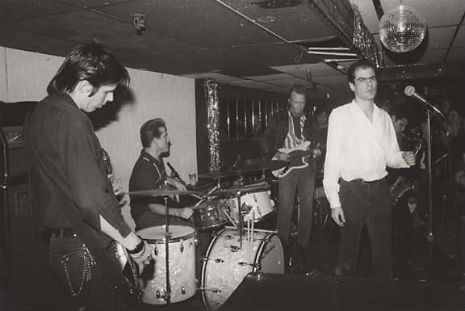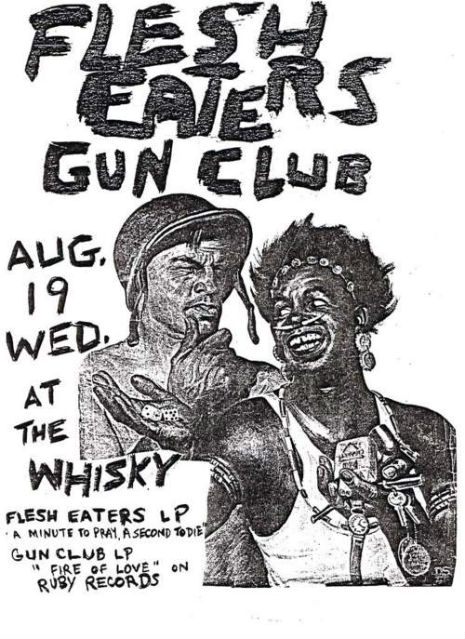The Flesh Eaters’ A Minute to Pray, A Second to Die album was one of the musical highlights of 1981—and certainly of the entire Los Angeles punk era—but outside of Southern California, or major cities, it wasn’t an easy record to find out about, let alone stumble across.
For A Minute To Pray, head Flesh Eater Chris Desjardins, aka Chris D., an aspiring filmmaker and writer for Slash magazine, assembled a “super group” from the LA punk scene: Dave Alvin (Blasters) on guitar, John Doe (X) on bass, Steve Berlin (Los Lobos) on sax, with Bill Bateman (Blasters) on drums and DJ Bonebrake (X) on the marimba. The group, unshackled from their “day job” bands, writes noted music maven Byron Coley in his liner notes, “all played like fucking maniacs.” (Coley also calls A Minute to Pray, A Second to Die “the best rock record ever recorded.” Whether or not this is objectively true, I’ll leave for you to decide, but hey, just having Byron Coley declare your record “the best” ever recorded is one hell of a compliment, isn’t it? The man is known for having exceptionally good taste.)
There is a dark, disturbing voodoo underpinning the album’s vision. Chris D.‘s lyrics were unique; he means to make you uncomfortable producing highly literate, yet grotesque noir poetry that went light years beyond anything Lou Reed would ever have had the guts to write about. Gothic, decadent, but in the sense of a completely bonkers, high IQ serial killer cooking up his heroin in a spoonful of absinthe. Jim Thompson meets Baudelaire at a bloody crime scene on Dia de los Muertos.

The Flesh Eaters, 1981. Photo by David Arnoff
Describing music in words (especially something this far out on a limb, esthetically speaking) is tricky sometimes, like asking a painter to make a sketch of a novel, but suffice to say that what we have here is a sonic maelstrom of fear and loathing, a ragged, jagged seedy sounding… I mean, the opening song sounds like a steampunk version of Captain Beefheart’s Magic Band fronted by an erudite Darby Crash. The squealing, skronky sax and pounding percussion—that marimba!!!—are striking indeed, as are the lunging, tug of war bluesy tribal rhythms. And that voice. If the lyrical preoccupations weren’t already scary enough, the spitting, crazed delivery of them will send chills down your spine. Rock scribe Richard Meltzer memorably described Desjardins’ voice as “a fully realized blabbermouth lockjaw of the soul, which you gotta admit is kinda neat.” Yeah!
Recently the ace archival label Superior Viaduct put out the first vinyl pressing of A Minute to Pray since 1981 and a newly remastered CD. I had not actually listened to the album since it came out and when the CD arrived in the post, I played it immediately. And then I played it again. And again. And again. I think I played it seven or eight times in a row that day. The next day a friend of mine came over and within about five seconds of hearing the opening whispers of “Digging My Grave”—I didn’t mention what it was—he exclaimed “I fucking love this album. I haven’t heard it… well, since I moved to LA. Saw ‘em live then, too!”
Lucky bastard. I caught up with Chris D. via email:
Missing children. Dogs licking up blood. Violent death. These were fairly novel things to sing about 33 years ago—and still are!—but your vocal delivery—so unhinged—is what sealed A Minute to Pray, A Second to Die as an authentic—albeit mutant—blues. The music is powerful and sleazy, but you just sound fucking insane. My first question is ‘so what sort of a fella were you back then, Chris?’
Well, I wasn’t crazy although I sometimes felt on the verge. I was a nice guy trying to exorcise demons, mostly relating to my love life. Much of the imagery was from films (the “dogs are licking up blood” and “squeeze out your milk on the baby’s grave” in the “Pray Til You Sweat” song were images from Eisenstein’s unfinished documentary, Que Viva Mexico.) Other lyrical influences are too numerous to mention, particularly from film, though literary giants like Poe, French symbolists like Lautreamont, Huysman, Baudelaire and pulp fiction maestros like Jim Thompson and James Cain were inspirations. There were televangelists on a local LA station that held up on camera the Minute to Pray LP cover along with some Ozzy Osbourne albums, using them as examples of satanic rock. Minute to Pray was never meant to be satanic. In fact, it was a symbolic exorcism.
How did the “supergroup” form and under what circumstances?
I got the brainstorm that it would be great to put these musician friends of mine, friends who had similar musical tastes to me, all into one group where we would try to synthesize a variety of both ethnic folk music traditions (African rhythms and chant melodies) with American pop/folk genres like 1950s/1960s swamp blues, instrumental rock & soul and late 1970s punk. Fortunately everyone brought their unique brand of aesthetics to the table, and everything blended seamlessly into an amazing hybrid.
What were rehearsals like?
A lot of fun, but very efficient because everyone intuitively knew what they needed to do to make their parts fit. I think we only rehearsed 8 or 9 times before we started recording. And we recorded everything, including the overdubs, in one night (some of the first take rough vocals were kept, though I don’t remember which ones). Mixing took about a week.
You played just a handful of gigs with the A Minute to Pray line-up, for the obvious reason that everyone else had their own bands. Was there anything particularly memorable about those shows?
They were all exhilarating. Not to disrespect any of the other great musicians I’ve played with, but it was phenomenal as these guys each brought something unique to the table, and there was a synchronicity to it all that we really didn’t have to work at. We were all on the same wavelength. My only lament is it is very difficult getting everyone together for reunion shows. We did 3 in California and 1 in the UK in 2006 – The first time since 1981. We’ve been talking about trying to do a few shows on the west coast in January 2015, so hopefully those will happen. On a side note, my ex-wife and co-lead vocalist in my other band Divine Horsemen, Julie Christensen, and I have been talking about possibly doing some Divine Horsemen reunion shows as well.
A Minute to Pray, A Second to Die is a seminal album, but not one that a whole lot of people have actually heard. It was never all that easy to hear back in the day—I for instance, taped it from a friend’s record—so for many people, this new re-release from Superior Viaduct will be their introduction to this 33-year-old album. Aren’t many more people likely to hear A Minute to Pray, A Second to Die in 2014 than heard it when it first came out?
That was always the case with records released by Ruby Records (Slash Records “budget” subsidiary). A Minute to Pray has actually been reissued on CD twice by Slash in the early-to-mid 1990s and then twice again by Rhino/WEA in the early 2000s, but then you would never know it because they did virtually no promotion (especially Rhino/WEA) and I don’t think they sold very well. The fans, they search that stuff out. But finding a new audience, it’s been hard. Superior Viaduct is doing a superior job (sub-licensing from Rhino) – this is the first time it’s been reissued on vinyl and the first time the CD actually has liner notes. They also have a genuinely great publicist working the release, and hopefully this will also be the case with the follow-up LP Forever Came Today by the Flesh Eaters from 1982, when it is reissued by them on vinyl, and out on CD for first time ever, early in 2015. That one is, I think, just as good as A Minute to Pray and much less well-known. So I’m hopeful a younger audience will rediscover both!
The vision on A Minute to Pray, A Second to Die is a dark one, but it was recorded a lifetime ago. How do you relate to those lyrical preoccupations today?
A lot of those preoccupations are still the same but I’ve achieved some transcendence and letting go of anger that I did not have back in 1981. Still the last year has not been a happy one and coincidentally, for the same time period, I’ve had writer’s block, which is devastating when writing is one of the ways I exorcise the demons. Between 2009 - 2013 I published 5 novels, 1 short story collection and a huge non-fiction volume Gun and Sword about Japanese yakuza films. But since around this time last year – as far as writing – nada. I’ve actually tried to write some song lyrics in the last couple of months but feel just so-so about the results.
I recently heard a hipster DJ—someone with very carefully sculpted sideburns and facial hair, you know the type—mash-up “Cyrano De Berger’s Back” with “Tenth Ave. Freeze Out.” Care to comment on this?
I didn’t even know what “Tenth Avenue Freeze-Out” was until I looked it up on YouTube! Not a Springsteen fan so I think I’ll let it go at that.
I can’t let you go without asking what are some of your favorite things that would go into an updated “Chris D.’s Video Guide” feature?
Oh, jeez, there is so much stuff. For folks inclined towards a really detailed answer, they can pick up my anthology book, also titled A Minute to Pray, A Second to Die [Highly recommended—RM] , off Amazon which not only has all my lyrics and poetry but also a listing (in the last 5 or 6 pages) of somewhere between 400-500 movie titles, with release dates and directors, that are recommended. As far as watching stuff at home lately, I’ve recently revisited some noir like Out of the Past, On Dangerous Ground, They Live by Night, David Lynch films Twin Peaks: Fire Walk With Me and Mulholland Drive, Elio Petri’s Investigation of a Citizen Above Suspicion and A Quiet Place in the Country, Friedkin’s Sorcerer, any samurai films directed by Hideo Gosha. Some stuff I caught in the theaters in the last few years that made an impression: Rust and Bone, A Place Beyond the Pines, Drive, Only God Forgives, Out of the Furnace, Cold in July and The Rover.
Chris D.‘s novels, Dragon Wheel Splendor and Other Love Stories of Violence and Dread, No Evil Star, Shallow Water: A Southern Gothic Noir Western and Mother’s Worry, along with his Japanese gangster encyclopedia Gun and Sword, are all available from Amazon.

The A Minute to Pray, A Second to Die line-up (Chris D., John Doe, Dave Alvin, Bill Bateman, Steve Berlin, D.J. Bonebrake) live at The Whisky a Go Go in 1981. The Gun Club (Chrs D. co-produced their Fire of Love album) were the opening act that night: